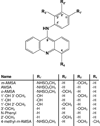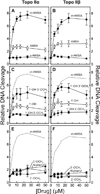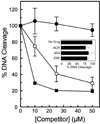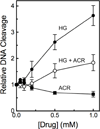Amsacrine as a topoisomerase II poison: importance of drug-DNA interactions
- PMID: 22304499
- PMCID: PMC3289736
- DOI: 10.1021/bi201159b
Amsacrine as a topoisomerase II poison: importance of drug-DNA interactions
Abstract
Amsacrine (m-AMSA) is an anticancer agent that displays activity against refractory acute leukemias as well as Hodgkin's and non-Hodgkin's lymphomas. The drug is comprised of an intercalative acridine moiety coupled to a 4'-amino-methanesulfon-m-anisidide headgroup. m-AMSA is historically significant in that it was the first drug demonstrated to function as a topoisomerase II poison. Although m-AMSA was designed as a DNA binding agent, the ability to intercalate does not appear to be the sole determinant of drug activity. Therefore, to more fully analyze structure-function relationships and the role of DNA binding in the action of m-AMSA, we analyzed a series of derivatives for the ability to enhance DNA cleavage mediated by human topoisomerase IIα and topoisomerase IIβ and to intercalate DNA. Results indicate that the 3'-methoxy (m-AMSA) positively affects drug function, potentially by restricting the rotation of the headgroup in a favorable orientation. Shifting the methoxy to the 2'-position (o-AMSA), which abrogates drug function, appears to increase the degree of rotational freedom of the headgroup and may impair interactions of the 1'-substituent or other portions of the headgroup within the ternary complex. Finally, the nonintercalative m-AMSA headgroup enhanced enzyme-mediated DNA cleavage when it was detached from the acridine moiety, albeit with 100-fold lower affinity. Taken together, our results suggest that much of the activity and specificity of m-AMSA as a topoisomerase II poison is embodied in the headgroup, while DNA intercalation is used primarily to increase the affinity of m-AMSA for the topoisomerase II-DNA cleavage complex.
Figures












Similar articles
-
Novel trifluoromethylated 9-amino-3,4-dihydroacridin-1(2H)-ones act as covalent poisons of human topoisomerase IIα.Bioorg Med Chem Lett. 2017 Feb 1;27(3):586-589. doi: 10.1016/j.bmcl.2016.12.011. Epub 2016 Dec 5. Bioorg Med Chem Lett. 2017. PMID: 27998679 Free PMC article.
-
Cross-resistance of an amsacrine-resistant human leukemia line to topoisomerase II reactive DNA intercalating agents. Evidence for two topoisomerase II directed drug actions.Biochemistry. 1991 Apr 23;30(16):4048-55. doi: 10.1021/bi00230a032. Biochemistry. 1991. PMID: 1850298
-
Intracellular molecular interactions of antitumor drug amsacrine (m-AMSA) as revealed by surface-enhanced Raman spectroscopy.FEBS Lett. 1996 Nov 11;397(1):61-4. doi: 10.1016/s0014-5793(96)01141-6. FEBS Lett. 1996. PMID: 8941714
-
Intercalator-induced, topoisomerase II-mediated DNA cleavage and its modification by antineoplastic antimetabolites.Int J Radiat Oncol Biol Phys. 1986 Jul;12(7):1041-7. doi: 10.1016/0360-3016(86)90222-1. Int J Radiat Oncol Biol Phys. 1986. PMID: 2427489 Review.
-
DNA-Binding Anticancer Drugs: One Target, Two Actions.Molecules. 2021 Jan 21;26(3):552. doi: 10.3390/molecules26030552. Molecules. 2021. PMID: 33494466 Free PMC article. Review.
Cited by
-
Synthesis and Evaluation of Antiproliferative Activity, Topoisomerase IIα Inhibition, DNA Binding and Non-Clinical Toxicity of New Acridine-Thiosemicarbazone Derivatives.Pharmaceuticals (Basel). 2022 Sep 2;15(9):1098. doi: 10.3390/ph15091098. Pharmaceuticals (Basel). 2022. PMID: 36145320 Free PMC article.
-
Synthesis and evaluation of anticancer activity of new 9-acridinyl amino acid derivatives.RSC Med Chem. 2020 Feb 14;11(3):378-386. doi: 10.1039/c9md00597h. eCollection 2020 Mar 1. RSC Med Chem. 2020. PMID: 33479643 Free PMC article.
-
Selective Inhibition of Escherichia coli RNA and DNA Topoisomerase I by Hoechst 33258 Derived Mono- and Bisbenzimidazoles.J Med Chem. 2017 Jun 22;60(12):4904-4922. doi: 10.1021/acs.jmedchem.7b00191. Epub 2017 May 31. J Med Chem. 2017. PMID: 28513176 Free PMC article.
-
Synthesis, DNA Binding, and Antiproliferative Activity of Novel Acridine-Thiosemicarbazone Derivatives.Int J Mol Sci. 2015 Jun 9;16(6):13023-42. doi: 10.3390/ijms160613023. Int J Mol Sci. 2015. PMID: 26068233 Free PMC article.
-
A Mini Review of Novel Topoisomerase II Inhibitors as Future Anticancer Agents.Int J Mol Sci. 2023 Jan 28;24(3):2532. doi: 10.3390/ijms24032532. Int J Mol Sci. 2023. PMID: 36768852 Free PMC article. Review.
References
-
- National Cancer Institute. Clinical Trials. 2011 http://www.cancer.gov/clinicaltrials/search/results?protocolsearchid=923....
-
- Jehn U, Heinemann V. New drugs in the treatment of acute and chronic leukemia with some emphasis on m-AMSA. Anticancer Res. 1991;11:705–711. - PubMed
-
- Kell J. Treatment of relapsed acute myeloid leukaemia. Rev. Recent Clin. Trials. 2006;1:103–111. - PubMed
Publication types
MeSH terms
Substances
Grants and funding
LinkOut - more resources
Full Text Sources

